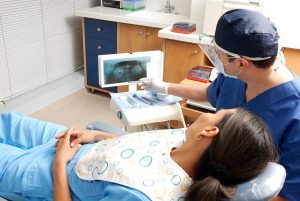Written by Harold Oster,MD. Results suggest that the use of probiotic lozenges is associated with improved recovery to baseline after plaque-induced gingivitis.
 Plaque-induced gingivitis is characterized by inflammation and bleeding and is a precursor to periodontitis, a more severe condition often resulting in bone and tooth loss. The prevalence of gingivitis in the United States may be as high as 80%1. Change in the oral microbiome in the presence of plaque is a significant factor in the development of gingivitis and periodontitis2. There is mixed evidence that probiotics may aid in the treatment and prevention of gingivitis3.
Plaque-induced gingivitis is characterized by inflammation and bleeding and is a precursor to periodontitis, a more severe condition often resulting in bone and tooth loss. The prevalence of gingivitis in the United States may be as high as 80%1. Change in the oral microbiome in the presence of plaque is a significant factor in the development of gingivitis and periodontitis2. There is mixed evidence that probiotics may aid in the treatment and prevention of gingivitis3.
Christine Lundtorp Olsen et al. studied the effects of probiotics on gingivitis induced by 14 days of absence of oral hygiene procedures. The authors recruited eighty medically and orally healthy young adults. The participants were randomly assigned to take probiotic lozenges containing Latilactobacillus curvatus and L. rhamnosus or placebo twice a day for the 28-day duration of the study. All participants refrained from toothbrushing and flossing for 14 days, then resumed dental hygiene procedures for the remainder of the study. Clinical examinations were performed, and salivary samples were obtained at baseline, day 14, and day 28. Levels of plaque were measured with the Modified Quigley and Hein Index4. The percentage of sites that bled on probing was recorded. The salivary samples were tested for proteins and inflammatory cytokines typically seen with gingivitis. Saliva was also tested for bacteria commonly found in healthy mouths and those with gingivitis5.
The authors noted the following:
- The level of plaque increased in both groups at day 14 and returned to baseline at day 28.
- Blood on probing (BOP) percent increased in both groups from baseline to day 14. In the placebo group, BOP percent remained elevated at day 28 compared to baseline (8.37% vs 5.36%), while in the probiotics group, BOP percent at day 28 did not differ significantly compared to baseline.
- BOP percentage and level of plaque did not differ significantly between the two groups throughout the study.
- Levels of inflammatory cytokines did not differ at any time point between the two groups.
- After 14 days of dental hygiene neglect, bacterial species known to be pathogenic in gingivitis increased in the placebo and probiotics groups.
- After 14 days of dental hygiene neglect, bacterial species seen in healthy mouths decreased in both groups.
- After the resumption of dental hygiene, levels of pathogenic species dropped, and those seen in healthy mouths increased in the probiotics group. The levels of pathogenic species and beneficial species did not improve in the placebo group.
- Salivary levels of albumin, total protein, chitinase, and amylase decreased in both groups. (In previous studies of gingivitis, these levels were found to increase6,7.) On day 14, the albumin decreased significantly only in the placebo group, and on day 28, the total protein was significantly lower than baseline only in the probiotics group. Otherwise, the changes in the two groups were similar throughout the study.
The authors concluded that probiotics are associated with improved recovery to baseline after experimental plaque-induced gingivitis. Limitations of the study include the lack of assessment of other cytokines associated with gingivitis and a sample size underpowered to detect smaller changes in clinical findings.
Source: Lundtorp Olsen, Christine, Laura Massarenti, Vincent Frederik Dahl Vendius, Ulvi Kahraman Gürsoy, Annina Van Splunter, Floris J. Bikker, Mervi Gürsoy, Christian Damgaard, Merete Markvart, and Daniel Belstrøm. “Probiotics Support Resilience of the Oral Microbiota during Resolution after Experimental Gingivitis—A Randomized, Double-Blinded, Placebo-Controlled Trial.” Nutrients 15, no. 22 (2023): 4805.
© 2023 by the authors. Licensee MDPI, Basel, Switzerland. This article is an open access article distributed under the terms and conditions of the Creative Commons Attribution (CC BY) license (https://
creativecommons.org/licenses/by/4.0/).
Click here to read the full text study.
Posted January 31, 2024.
Harold Oster, MD graduated from medical school in Miami, Florida in 1992 and moved to Minnesota in 2004. After more than 25 years of practicing Internal Medicine, he recently retired. Dr. Oster is especially interested in nutrition, weight management, and disease prevention.
References:
- Trombelli L, Farina R, Silva CO, Tatakis DN. Plaque-induced gingivitis: Case definition and diagnostic considerations. J Clin Periodontol. Jun 2018;45 Suppl 20:S44-s67. doi:10.1111/jcpe.12939
- Murakami S, Mealey BL, Mariotti A, Chapple ILC. Dental plaque-induced gingival conditions. J Periodontol. Jun 2018;89 Suppl 1:S17-s27. doi:10.1002/jper.17-0095
- Akram Z, Shafqat SS, Aati S, Kujan O, Fawzy A. Clinical efficacy of probiotics in the treatment of gingivitis: A systematic review and meta-analysis. Aust Dent J. Mar 2020;65(1):12-20. doi:10.1111/adj.12733
- Cugini M, Thompson M, Warren PR. Correlations between two plaque indices in assessment of toothbrush effectiveness. J Contemp Dent Pract. Nov 1 2006;7(5):1-9.
- Huang S, Li Z, He T, et al. Microbiota-based Signature of Gingivitis Treatments: A Randomized Study. Sci Rep. Apr 20 2016;6:24705. doi:10.1038/srep24705
- Kejriwal S, Bhandary R, Thomas B, Kumari S. Estimation of levels of salivary mucin, amylase and total protein in gingivitis and chronic periodontitis patients. J Clin Diagn Res. Oct 2014;8(10):Zc56-60. doi:10.7860/jcdr/2014/8239.5042
- Henskens YM, van der Velden U, Veerman EC, Nieuw Amerongen AV. Protein, albumin and cystatin concentrations in saliva of healthy subjects and of patients with gingivitis or periodontitis. Journal of periodontal research. Jan 1993;28(1):43-8. doi:10.1111/j.1600-0765.1993.tb01049.x
